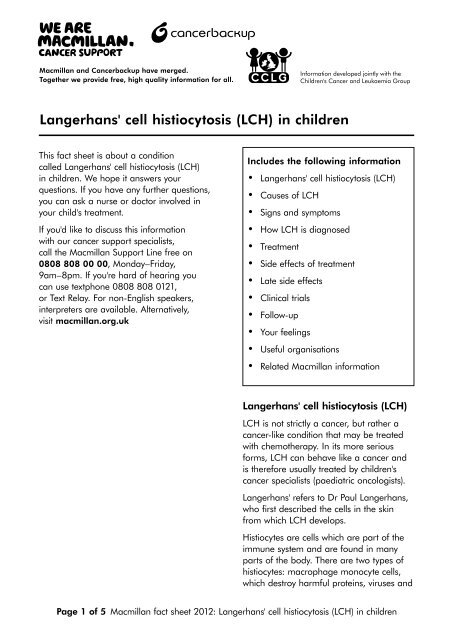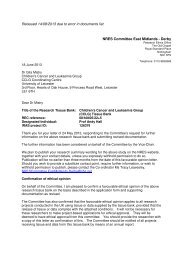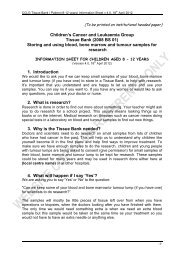Langerhans' cell histiocytosis (LCH) in children
Langerhans' cell histiocytosis (LCH) in children
Langerhans' cell histiocytosis (LCH) in children
Create successful ePaper yourself
Turn your PDF publications into a flip-book with our unique Google optimized e-Paper software.
Macmillan and Cancerbackup have merged.Together we provide free, high quality <strong>in</strong>formation for all.Information developed jo<strong>in</strong>tly with theChildren's Cancer and Leukaemia Group<strong>Langerhans'</strong> <strong>cell</strong> <strong>histiocytosis</strong> (<strong>LCH</strong>) <strong>in</strong> <strong>children</strong>This fact sheet is about a conditioncalled <strong>Langerhans'</strong> <strong>cell</strong> <strong>histiocytosis</strong> (<strong>LCH</strong>)<strong>in</strong> <strong>children</strong>. We hope it answers yourquestions. If you have any further questions,you can ask a nurse or doctor <strong>in</strong>volved <strong>in</strong>your child's treatment.If you'd like to discuss this <strong>in</strong>formationwith our cancer support specialists,call the Macmillan Support L<strong>in</strong>e free on0808 808 00 00, Monday–Friday,9am–8pm. If you're hard of hear<strong>in</strong>g youcan use textphone 0808 808 0121,or Text Relay. For non-English speakers,<strong>in</strong>terpreters are available. Alternatively,visit macmillan.org.ukIncludes the follow<strong>in</strong>g <strong>in</strong>formation• <strong>Langerhans'</strong> <strong>cell</strong> <strong>histiocytosis</strong> (<strong>LCH</strong>)• Causes of <strong>LCH</strong>• Signs and symptoms• How <strong>LCH</strong> is diagnosed• Treatment• Side effects of treatment• Late side effects• Cl<strong>in</strong>ical trials• Follow-up• Your feel<strong>in</strong>gs• Useful organisations• Related Macmillan <strong>in</strong>formation<strong>Langerhans'</strong> <strong>cell</strong> <strong>histiocytosis</strong> (<strong>LCH</strong>)<strong>LCH</strong> is not strictly a cancer, but rather acancer-like condition that may be treatedwith chemotherapy. In its more seriousforms, <strong>LCH</strong> can behave like a cancer andis therefore usually treated by <strong>children</strong>'scancer specialists (paediatric oncologists).<strong>Langerhans'</strong> refers to Dr Paul Langerhans,who first described the <strong>cell</strong>s <strong>in</strong> the sk<strong>in</strong>from which <strong>LCH</strong> develops.Histiocytes are <strong>cell</strong>s which are part of theimmune system and are found <strong>in</strong> manyparts of the body. There are two types ofhistiocytes: macrophage monocyte <strong>cell</strong>s,which destroy harmful prote<strong>in</strong>s, viruses andPage 1 of 5 Macmillan fact sheet 2012: <strong>Langerhans'</strong> <strong>cell</strong> <strong>histiocytosis</strong> (<strong>LCH</strong>) <strong>in</strong> <strong>children</strong>
acteria <strong>in</strong> the body; and dendritic <strong>cell</strong>s,which stimulate the immune system.<strong>Langerhans'</strong> <strong>cell</strong>s are dendritic <strong>cell</strong>s andare normally only found <strong>in</strong> the sk<strong>in</strong> andmajor airways. In <strong>LCH</strong>, the <strong>Langerhans'</strong><strong>cell</strong>s are abnormal and spread via thebloodstream <strong>in</strong>to many parts of the body,<strong>in</strong>clud<strong>in</strong>g the bone marrow, sk<strong>in</strong>, lungs,liver, lymph glands, spleen and pituitarygland. When <strong>Langerhans'</strong> <strong>cell</strong>s are present<strong>in</strong> these tissues, they may cause damage.<strong>LCH</strong> is divided <strong>in</strong>to two groups:• s<strong>in</strong>gle-system <strong>LCH</strong>, when the diseaseaffects only one part of the body,for example, the sk<strong>in</strong> or the bone• multi-system <strong>LCH</strong>, when it affects morethan one part of the body.About 50 <strong>children</strong> <strong>in</strong> the UK develop<strong>Langerhans'</strong> <strong>cell</strong> <strong>histiocytosis</strong> (<strong>LCH</strong>) eachyear. It can affect <strong>children</strong> of any age,and is more common <strong>in</strong> boys than <strong>in</strong> girls.Causes of <strong>LCH</strong>The cause of <strong>LCH</strong> is unknown. It cannotbe caught from other people and is notpassed on <strong>in</strong> families.Signs and symptomsThe symptoms of <strong>LCH</strong> will depend onwhich part of the body is affected andwhether the disease is affect<strong>in</strong>g more thanone part of the body.If <strong>LCH</strong> affects the bone, this can causepa<strong>in</strong> <strong>in</strong> the bone and/or swell<strong>in</strong>g/lumps onthe skull. If the sk<strong>in</strong> is affected, a sk<strong>in</strong> rash,such as cradle cap and nappy rash, mayoccur. A discharge from the ear or hear<strong>in</strong>gproblems can occur if the ear is affected.If <strong>LCH</strong> affects the lungs or chest, the childmay have breath<strong>in</strong>g difficulties. <strong>LCH</strong> with<strong>in</strong>the abdomen may cause tummy problems,such as diarrhoea, and liver problems,<strong>in</strong>clud<strong>in</strong>g jaundice. The lymph glands maybe enlarged. Children may be irritable andhave a poor appetite.In 2–3 out of every 10 <strong>children</strong> withmulti-system disease, the pituitary glandat the base of the bra<strong>in</strong> is affected, caus<strong>in</strong>ghormonal problems. This can lead to thechild pass<strong>in</strong>g larger amounts of ur<strong>in</strong>e andbe<strong>in</strong>g very thirsty. This is called diabetes<strong>in</strong>sipidus, which is different from sugardiabetes and can be well controlled withspecific medic<strong>in</strong>es. Occasionally, otherpituitary hormones may be affectedcaus<strong>in</strong>g poor growth or delayed puberty,which aga<strong>in</strong> can be treated.How <strong>LCH</strong> is diagnosedA variety of tests and <strong>in</strong>vestigations maybe needed to diagnose <strong>LCH</strong>. X-rays willoften be taken of the bones, the skull,and the lungs. Blood tests will also betaken. These tests help the doctors todecide if the disease is a s<strong>in</strong>gle-systemor multi‐system type.Tests are likely to <strong>in</strong>clude the removal of asample of <strong>cell</strong>s (biopsy), and this is usuallydone <strong>in</strong> an operation, under a generalanaesthetic. The <strong>cell</strong>s are exam<strong>in</strong>edunder a microscope. An MRI (magenticresonance imag<strong>in</strong>g) scan of the bra<strong>in</strong> mayalso be carried out.Any tests and <strong>in</strong>vestigations that your childneeds will be expla<strong>in</strong>ed to you. The bookletA parent’s guide to <strong>children</strong>’s cancers, givesdetails of what the tests and scans <strong>in</strong>volve.TreatmentS<strong>in</strong>gle-system <strong>LCH</strong> may disappear onits own without any treatment. Thismay occur follow<strong>in</strong>g a biopsy. In some<strong>children</strong>, treatment such as surgery andcorticosteroids (such as prednisolone) maybe used.Multi-system disease is usually treatedwith chemotherapy and corticosteroids.The length of treatment varies from childto child.Chemotherapy is the use of anti-cancer(cytotoxic) drugs to destroy cancer<strong>cell</strong>s, and corticosteroids are hormonalPage 2 of 5 Macmillan fact sheet 2012: <strong>Langerhans'</strong> <strong>cell</strong> <strong>histiocytosis</strong> (<strong>LCH</strong>) <strong>in</strong> <strong>children</strong>
substances which are naturally produced<strong>in</strong> the body. Both chemotherapy andcorticosteroids can help to destroy the<strong>LCH</strong> <strong>cell</strong>s.Side effects of treatmentChemotherapy and corticosteroids usedto treat <strong>LCH</strong> may cause side effects, andyour child's doctor will discuss these withyou before treatment starts. Any possibleside effects will depend upon the particulartreatment be<strong>in</strong>g used and the part of thebody that is be<strong>in</strong>g treated.Side effects of chemotherapy can <strong>in</strong>clude:feel<strong>in</strong>g sick (nausea) and vomit<strong>in</strong>g, hairloss, an <strong>in</strong>creased risk of bruis<strong>in</strong>g andbleed<strong>in</strong>g, and tiredness. Corticosteroidsmay cause a round<strong>in</strong>g of the face(sometimes called a moon face), moodchanges, and an <strong>in</strong>creased appetite, whichcan lead to weight ga<strong>in</strong>. All of these sideeffects are reversible when treatment stops.Late side effectsSome <strong>children</strong> may develop after-effectsof the disease. These effects can happenwith<strong>in</strong> months or years of the diagnosisand are more likely to be due to thedisease itself than to the treatment given.However, a few <strong>children</strong> may develop lateeffects from the drugs or the treatmentthey receive.Possible late side effects <strong>in</strong>clude reduction<strong>in</strong> bone growth, delayed puberty, hear<strong>in</strong>gproblems, and lung problems.Cl<strong>in</strong>ical trialsMany <strong>children</strong> have their treatment as partof a cl<strong>in</strong>ical research trial. Trials aim toimprove our understand<strong>in</strong>g of the best wayto treat an illness, usually by compar<strong>in</strong>g thestandard treatment with a new or modifiedversion. Research has found that peoplereceiv<strong>in</strong>g treatment with<strong>in</strong> cl<strong>in</strong>ical trials tendto do as well as, or better than, similarpatients treated outside cl<strong>in</strong>ical trials.This does not mean that trial treatmentsare always better; hospitals that carry outtrials do however have access to goodequipment and follow precise guidel<strong>in</strong>eswhen giv<strong>in</strong>g treatment.The treatment trials for <strong>LCH</strong> are set upand organised by The Histiocyte Society,a group of <strong>in</strong>ternational specialists <strong>in</strong><strong>histiocytosis</strong>. If appropriate, your child'smedical team will talk to you about tak<strong>in</strong>gpart <strong>in</strong> a cl<strong>in</strong>ical trial and will answerany questions you may have. Written<strong>in</strong>formation is often provided to helpexpla<strong>in</strong> th<strong>in</strong>gs.Tak<strong>in</strong>g part <strong>in</strong> a research trial is completelyvoluntary, and you'll be given time todecide if it's right for your child.Follow-upBetween eight and n<strong>in</strong>e of every 10<strong>children</strong> who develop <strong>LCH</strong> will recoverfrom it. Sometimes the disease can comeback, and so <strong>children</strong> will have regularcheck-ups <strong>in</strong> the outpatients cl<strong>in</strong>ic.Follow-up is also important to look outfor late side effects. If you have specificconcerns about your child’s condition andtreatment, it's best to discuss them withyour child’s specialist medical team whoknow the situation <strong>in</strong> detail.Your feel<strong>in</strong>gsAs a parent, the fact that your child has aserious illness is one of the worst situationsthat you can be faced with. You may havemany different emotions, such as fear, guilt,sadness, anger and uncerta<strong>in</strong>ty. These areall normal reactions and are part of theprocess that many parents go through atsuch a difficult time.It's not possible to address <strong>in</strong> this factsheet all of the feel<strong>in</strong>gs you may have.However, the Macmillan/CCLG bookletA parent’s guide to <strong>children</strong>’s cancers talksabout the emotional impact of car<strong>in</strong>gfor an unwell child and suggests sourcesof help and support.Page 3 of 5 Macmillan fact sheet 2012: <strong>Langerhans'</strong> <strong>cell</strong> <strong>histiocytosis</strong> (<strong>LCH</strong>) <strong>in</strong> <strong>children</strong>
Your child may have a range of powerfulemotions throughout their experienceof illness. The parent's guide discussesthis further and talks about how you cansupport your child.Our booklet Pepperm<strong>in</strong>t Ward is astorybook for younger <strong>children</strong> with cancer.It looks at the issues they and their familymay face, and helps them explore theirfeel<strong>in</strong>gs.Useful organisationsChildren's Cancer and LeukaemiaGroup (CCLG)University of Leicester, 3 rd Floor, Heartsof Oak House, 9 Pr<strong>in</strong>cess Road West,Leicester LE1 6THTel 0116 249 4460 (ma<strong>in</strong> office)Email <strong>in</strong>fo@cclg.org.ukwww.cclg.org.ukCoord<strong>in</strong>ates research and care for <strong>children</strong>and their parents. There are 21 CCLGspecialist centres for the treatment ofchildhood cancer and leukaemia, cover<strong>in</strong>gall areas of the UK and Ireland (there's amap of the centres on the website). Has<strong>in</strong>formation about the CCLG, childhoodcancer and leukaemia.CLIC SargentGriff<strong>in</strong> House, 161 Hammersmith Road,London W6 8SGTel 0300 330 0803Email <strong>in</strong>fo@clicsargent.org.ukwww.clicsargent.org.ukOffers practical support to <strong>children</strong> andyoung people with cancer or leukaemia,and to their families.The Histiocytosis Associationwww.histio.orgAn <strong>in</strong>ternational partnership of patients,families, physicians and friends, whichaims to promote scientific research andeducation related to <strong>histiocytosis</strong>. It aims toprovide solutions to some of the problemsthat are specific to patients suffer<strong>in</strong>g fromthis disease, and to offer support to patientsand their families.Histiocytosis Research Trust18 Western Road, Wylde Green, SuttonColdfield B73 5SPTel 0121 355 5137Email <strong>in</strong>fo@hrtrust.orgwww.hrtrust.orgFormed to promote and fund scientificresearch <strong>in</strong>to histiocytoses. The trust hasalso created a ‘Circle of Friends’ for mutualsupport through <strong>in</strong>formation, newslettersand roadshows led by medical experts.In touch with many families around theUK and overseas.Related Macmillan <strong>in</strong>formation• A parent's guide to <strong>children</strong>'s cancers• Katie's Garden (a storybook for primaryschool-age <strong>children</strong> about a girl'sexperience of cancer)• Pepperm<strong>in</strong>t Ward – a story about<strong>children</strong> with cancer• Understand<strong>in</strong>g cancer research trials(cl<strong>in</strong>ical trials)• Understand<strong>in</strong>g chemotherapy• Understand<strong>in</strong>g radiotherapyFor copies of this related <strong>in</strong>formation callfree on 0808 808 00 00, or see it onl<strong>in</strong>eat macmillan.org.ukOur website click4tic.org.uk has cancer<strong>in</strong>formation written specifically for youngpeople. Get advice and support, andconnect with other young people affectedby cancer.This fact sheet has been written, revised and editedby Macmillan Cancer Support’s Cancer InformationDevelopment team. It has been approved by ourmedical editor, Dr Terry Priestman, ConsultantCl<strong>in</strong>ical Oncologist.With thanks to: Dr Kev<strong>in</strong> W<strong>in</strong>debank, SeniorLecturer <strong>in</strong> child health & Consultant paediatric andadolescent oncologist; and the people affected bycancer who reviewed this edition.Page 4 of 5 Macmillan fact sheet 2012: <strong>Langerhans'</strong> <strong>cell</strong> <strong>histiocytosis</strong> (<strong>LCH</strong>) <strong>in</strong> <strong>children</strong>
This fact sheet has been compiled us<strong>in</strong>g <strong>in</strong>formationfrom a number of reliable sources, <strong>in</strong>clud<strong>in</strong>g:• Voute PA, et al. Cancer <strong>in</strong> Children: Cl<strong>in</strong>icalManagement. 5 th edition. 2005. OxfordUniversity Press.• P<strong>in</strong>kerton, et al. Evidence-based paediatriconcology. 2 nd edition. 2007. BlackwellPublish<strong>in</strong>g.• McLa<strong>in</strong> KL. Langerhans <strong>cell</strong> <strong>histiocytosis</strong>,Juvenile xanthogranuloma, and Erdheim-Chester disease. www.uptodate.com(accessed October 2010).This fact sheet was revised <strong>in</strong> 2011. The next editionwill be available <strong>in</strong> 2013.We make every effort to ensure that the<strong>in</strong>formation we provide is accurate but it shouldnot be relied upon to reflect the current state ofmedical research, which is constantly chang<strong>in</strong>g.If you are concerned about your health, youshould consult your doctor. Macmillan cannotaccept liability for any loss or damage result<strong>in</strong>gfrom any <strong>in</strong>accuracy <strong>in</strong> this <strong>in</strong>formation orthird-party <strong>in</strong>formation such as <strong>in</strong>formation onwebsites to which we l<strong>in</strong>k.© Macmillan Cancer Support 2012. Registeredcharity <strong>in</strong> England and Wales (261017),Scotland (SC039907) and the Isle of Man(604). Registered office 89 Albert Embankment,London, SE1 7UQ.MAC11870_12Page 5 of 5 Macmillan fact sheet 2012: <strong>Langerhans'</strong> <strong>cell</strong> <strong>histiocytosis</strong> (<strong>LCH</strong>) <strong>in</strong> <strong>children</strong>






